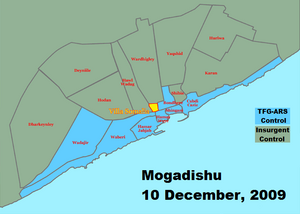This section includes a list of general references, but it lacks sufficient corresponding inline citations. (September 2021) |
| Battle of Mogadishu (2009) | |||||||||
|---|---|---|---|---|---|---|---|---|---|
| Part of Somali Civil War, War in Somalia (2009-present) | |||||||||
 Control of Mogadishu after the battle | |||||||||
| |||||||||
| Belligerents | |||||||||
|
| |||||||||
| Commanders and leaders | |||||||||
|
|
| ||||||||
| Strength | |||||||||
| Al-Shabaab: 2,500[1] | AMISOM: 4,350[2] | ||||||||
| Casualties and losses | |||||||||
| 94+ killed*[3] |
Total: 126+ KIA | ||||||||
|
1,497 civilians killed3 | |||||||||
1 Sheik Yusuf Mohamed Siad "Indho Ade" (a warlord who is notorious for switching sides), and his militia were part of Hizbul Islam until 17 May, when he defected to the government.[8] | |||||||||
The Battle of Mogadishu (2009) started in May with an Islamist offensive, when rebels from al-Shabaab and Hizbul Islam attacked and captured government bases in the capital of Mogadishu.[citation needed] The fighting soon spread, causing hundreds of casualties, and continued on at various levels of intensity until October. The battle's name usually includes the year, when referenced, in order to distinguish it amongst the nine major Battles of Mogadishu during the decades long Somali Civil War.
The Islamist offensive lasted from 8 to 14 May and ended with relative success as they managed to take control over most of the capital, while ARS-D and government (TFG) forces withdrew into AMISOM protected territories.[citation needed] But despite major gains, the rebels failed to topple the government during the eight days of fighting and small scale clashes continued until 22 May, when the government launched a major offensive to retake the city, as Islamist forces had mostly withdrawn into the Central Region and the government was now backed by powerful warlord Indho Ade.[citation needed]
The government offensive initially had some success as they captured a few bases, however in a matter of hours the Islamist launched a successful counter offensive and re-captured the lost areas and made even more gains. As a result, the government offensive was aborted on 23 May.[citation needed]
The offensive was however resumed on 1 June, resulting in a third round of fighting which lasted until 4 June and saw the government make enormous gains.[citation needed] Islamists launched a new offensive on 16 June, lasting until 23 June, entering government strongholds in Eastern Mogadishu for the first time, the offensive was relatively successful and saw most neighbourhoods in Kaaraan, Shibis, Abdiaziz and Wardhigley fall to their control.[citation needed]
The government launched another offensive on 1 July, insurgents however successfully repelled the offensive, making gains until 5 July, when al-Shabaab's leader Sheikh Moktar Ali Zubeyr gave government forces a five-day ultimatum to hand over their weapons.[citation needed] The ultimatum was however rejected [citation needed] and so, al-Shabaab launched several attacks on key sites in the city [citation needed] provoking a major government offensive on 11 – 12 July,[citation needed] which led to a total expulsion of Islamist forces from the city.[citation needed] Islamists however returned on 13 July,[citation needed] with large re-enforcements from the South Eastern Region,[citation needed] government forces withdrew from all captured positions [citation needed] and minor clashes continued.[citation needed] A Seventh round of fighting was finally held between 21 and 27 August,[citation needed] which ended mostly indecisive.[citation needed] In early October the Al-Shabaab-Hizbul Islam alliance [citation needed] was broken by a power struggle in Kisimayo [citation needed] were after the two groups turned on each other.[citation needed] Both groups kept up their fight with the TFG [citation needed] however the split between the two groups marked a downwards trend in violence.[citation needed]
A report Elman Peace and Human Rights group at the end of the year said that 1,739 people had been killed throughout 2009 by violence in Mogadishu.[11]
- ^ a b "UNSC Somalia Report" (PDF)., 1 November 2009
- ^ "Report – Southern Somalia: The security situation" (PDF).
- ^ Insurgent Casualties: "Reference at abcnews.go.com". ABC News., "Clashes in Somalia kill 139 civilians". Reuters., "Dozens of civilians killed in latest Somalia fighting - CNN.com". CNN., "Breaking News, World News and Video from Al Jazeera"., "Reference at allafrica.com"., "Reference at www.france24.com".[permanent dead link], "BBC NEWS | Africa | Battle kills Somali police chief". 17 June 2009., "Reference at allafrica.com"., "Foreign fighter may be among 16 killed in Somalia - Deseret News". Deseret News., "Reference at allafrica.com"., "Reference at www.news24.com". Archived from the original on 9 January 2010. Retrieved 23 August 2009., "Reference at allafrica.com"., "Reference at allafrica.com".
- ^ Government Casualties: "Reference at abcnews.go.com". ABC News., "Clashes in Somalia kill 139 civilians". Reuters., "Dozens of civilians killed in latest Somalia fighting - CNN.com". CNN., "Breaking News, World News and Video from Al Jazeera"., "Reference at allafrica.com"., "Reference at allafrica.com"., "Reference at allafrica.com"., "Reference at www.france24.com".[permanent dead link], "Reference at www.garoweonline.com". Archived from the original on 13 March 2012. Retrieved 30 August 2009., "BBC NEWS | Africa | Battle kills Somali police chief". 17 June 2009., "Reference at allafrica.com"., "Reference at allafrica.com"., "Foreign fighter may be among 16 killed in Somalia - Deseret News". Deseret News., "Reference at allafrica.com"., "Reference at allafrica.com"., "Reference at allafrica.com"., "Reference at allafrica.com"., "Reference at allafrica.com"., "Reference at allafrica.com"., "Reference at allafrica.com"., "Reference at allafrica.com".,
- ^ AMISOM Casualties: "Reference at allafrica.com"., "Reference at allafrica.com"., "Reference at allafrica.com"., "Humanitarian | Thomson Reuters Foundation News"., "Reference at allafrica.com".,"VOA News - 21 Killed in Suicide Bomb Attacks on AU Forces in Mogadishu". Archived from the original on 23 September 2009., "Reference at allafrica.com".
- ^ allafrica "More Than 1,700 Killed in Clashes in 2009 – Group"., 1 January 2010
- ^ allafrica "Displacement Update – Growing Insecurity Cuts Off Aid Access"., 21 July 2009
- ^ allafrica "Islamist Leader Defects to Government"., 17 May 2009
- ^ allafrica "Insurgent Commander Killed in Mogadishu"., 30 May 2009
- ^ allafrica "Nearly 100,000 Somalis Displaced in Capital in Past Month, UN Reports"., 5 June 2009
- ^ "Reference at allafrica.com".